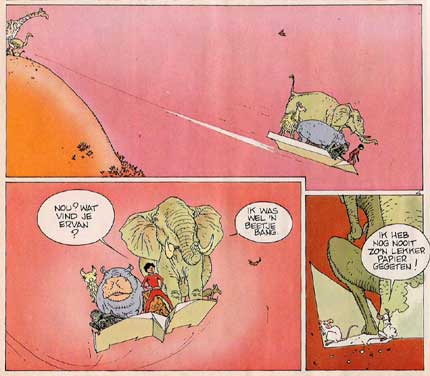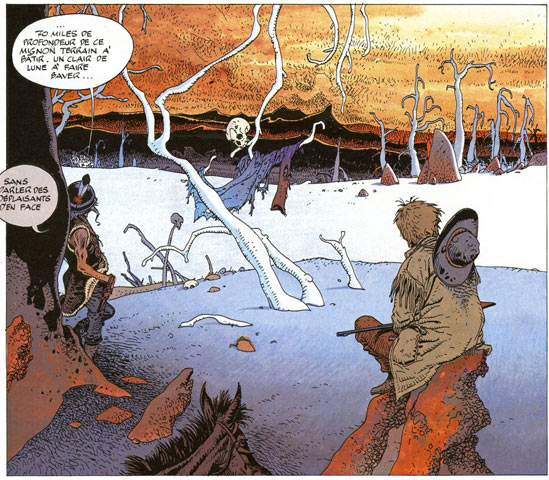Jeremiah #22 - 'Le Fusil dans l’Eau'.
Hermann Huppen, who signs with solely his first name, is one of the most popular Belgian artists. He took evening art courses at the Saint-Gilles in Brussels, and started out working as an interior designer, participating in the Expo 58, among other projects. He also worked in Montreal and New York for a short period. It was his brother-in-law Philippe Vandooren (the future editor-in-chief of Spirou) who introduced him to the field of comics. Vandooren assigned him to do a short story for the boy scout magazine Plein-Feu, of which he was the editor at the time. By 1964, Hermann joined the art studios of Michel Greg. During the same period, he illustrated some stories in the series 'Les Belles Histoires de l'Oncle Paul' for Spirou magazine.
'Bernard Prince'.
With Greg as his scenarist, Hermann broke through with the adventure series 'Bernard Prince' in Tintin in 1966. While continuing this series, he also did some independent stories, as well as the first episodes of the 'Jugurtha' series (written by Jean-Luc Vernal). In 1969, he started on a second series with Greg, the western 'Comanche'. More dramatic and hard-boiled than for instance 'Blueberry' and 'Jerry Spring', 'Comanche' ranks among the best series in the genre. After ten years, Hermann canceled his collaboration with Greg to begin series of his own.
His first solo comic was the 'Jeremiah' series, which he initially created for the German publisher Koralle. This grim post-apocalyptic fantasy was an instant hit and remains Hermann's most famous work. In later years, Hermann began using direct colors on his 'Jeremiah' pages, which enlarged the series' dark atmospere.
'Nic', Spirou, 1981.
For Spirou, Hermann drew the poetic stories about the dreaming boy 'Nic', a modern day take on 'Little Nemo', from 1980 to 1983 (written by Morphée, a pseudonym for Vandooren). He began his second big solo series in 1984: the historical 'Les Tours de Bois-Maury'. By then, Hermann joined the Yugoslavian Strip Art Features agency, that distributed his work from then on.
'Les Tours de Bois-Maury' #5 - Alda (1988).
Since the early 1990s, Hermann has alternated his work on 'Jeremiah' and 'Bois-Maury' with several independent stories. The first was 'Missié Vandisandi' (1991), that appeared in the Aire Libre collection of Dupuis. He aided his son Yves H. on the comic 'Le Secret des Hommes Chiens' in 1995, and in that same year he came up with a touching comment on the situation in former Yugoslavia with 'Sarajevo-Tango', also published by Dupuis. His third Aire Libre appeared in 1999, the western 'On a Tué Wild Bill'. A year later, Hermann teamed up with Jean Van Hamme to create 'Lune de Guerre'.
Jeremiah - 'Les Yeux de Fer Rouge'.
Hermann's son Yves has scripted several stories for his father since 2000. Together they made such comics as 'Liens de Sang' (Lombard, 2000), 'Rodrigo' (in the series 'Tours de Bois-Maury', Glénat, 2001), 'Manhattan Beach 1957' (Lombard, 2002), 'Zhong Guo' (Dupuis, 2003), 'The Girl from Ipanema' (Lombard, 2005), the diptych 'Diable des sept mers' (Dupuis, 2008-09), a new 'Bernard Prince' story (Lombard, 2010), 'Retour au Congo' (Glénat, 2013) and 'Station 16' (Lombard, 2014).
Hermann was one of several artists to make a graphic contribution to ‘Pepperland’ (1980), a collective comic book tribute to the store Pepperland, to celebrate its 10th anniversary at the time. He was one of several artists to make a graphic contribution to 'Baston Labaffe no. 5: La Ballade des Baffes’ (Goupil, 1983), an official collective parody comic of André Franquin’s 'Gaston Lagaffe’. He paid tribute to Nikita Mandryka in the collective comic book 'Tronches de Concombre' (Dupuis, 1995).
In October 1999, a comic book mural depicting 'Les Rêves de Nic' was inaugurated at the corner of the Rue des Fabriques / Fabrieksstraat and the Rue de la Senne / Zennestraat in Brussels, as part of the Brussels Comic Book Route.
In Belgium, Hermann was an influence on Thierry Van Hasselt. In France, he inspired Didier Tarquin. He also found followers and disciples in Denmark (Henrik Rehr), Italy (Stefano Carloni), The Netherlands (Anco Dijkman, Peter van Dongen), Serbia (Mirko Colak), Switzerland (Enrico Marini, Rafael Moralès) and the United States (Charles Vess).








